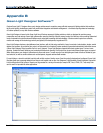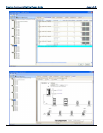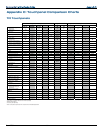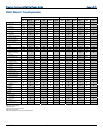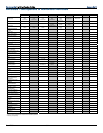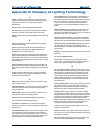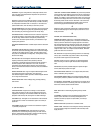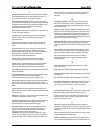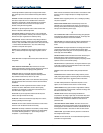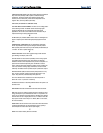
Commercial Lighting Design Guide Appendix E
Doc. 4775A 98
Appendix E: Glossary of Lighting Terminology
A
AMPERE: The standard unit of measurement for electric current that
is equal to one coulomb per second. It defines the quantity of electrons
moving past a given point in a circuit during a specific period,
abbreviated amp.
ANSI: Abbreviation for American National Standards Institute
ARC TUBE: A tube enclosed by the outer glass envelope of a HID lamp
and made of clear quartz or ceramic that contains the arc stream
ASHRAE: American Society of Heating, Refrigerating and Air-Conditioning
Engineers
B
BAFFLE: A single opaque or translucent element used to control light
distribution at certain angles
BALLAST: A device used to operate fluorescent and HID lamps. The
ballast provides the necessary starting voltage, while limiting and
regulating the lamp current during operation
BALLAST CYCLING: Undesirable condition under which the ballast turns
lamps on and off (cycles) due to the overheating of the thermal switch
inside the ballast. This may be due to incorrect lamps, improper voltage
being supplied, high ambient temperature around the fixture, or the early
stage of ballast failure
BALLAST EFFICIENCY FACTOR: The ballast efficiency factor (BEF) is the
ballast factor (see below) divided by the input power of the ballast. The
higher the BEF (within the same lamp-ballast type) the more efficient the
ballast.
BALLAST FACTOR: The ballast factor (BF) for a specific lamp-ballast
combination represents the percentage of the rated lamp lumens that
will be produced by the combination
C
CANDELA: Unit of luminous intensity, describing the intensity of a light
source in a specific direction
CANDELA DISTRIBUTION: A curve, often on polar coordinates, illustrating
the variation of luminous intensity of a lamp or luminaire in a plane
through the light center
CANDLEPOWER: A measure of luminous intensity of a light source in a
specific direction, measured in candelas (see above)
CBM: Abbreviation for Certified Ballast Manufacturers Association.
CEC: Abbreviation for California Energy Commission
COEFFICIENT OF UTILIZATION: The ratio of lumens from a luminaire
received on the work plane to the lumens produced by the lamps alone.
(Also called "CU")
COLOR RENDERING INDEX (CRI): A scale of the effect of a light source on
the color appearance of an object compared to its color appearance
under a reference light source. Expressed on a scale of 1 to 100, where
100 indicates no color shift. A low CRI rating suggests that the colors of
objects will appear unnatural under that particular light source
COLOR TEMPERATURE: The color temperature is a specification of the
color appearance of a light source, relating the color to a reference
source heated to a particular temperature, measured by the thermal unit
Kelvin. The measurement can also be described as the "warmth" or
"coolness" of a light source. Generally, sources below 3200K are
considered "warm;" while those above 4000K are considered "cool"
sources
COMPACT FLUORESCENT: A small fluorescent lamp that is often used
as an alternative to incandescent lighting. The lamp life is about 10
times longer than incandescent lamps and is 3-4 times more efficacious.
Also called PL, Twin-Tube, CFL, or BIAX lamps
CONSTANT WATTAGE (CW) BALLAST: A premium type of HID ballast in
which the primary and secondary coils are isolated. It is considered a
high performance, high loss ballast featuring excellent output regulation
CONSTANT WATTAGE AUTOTRANSFORMER (CWA) BALLAST: A popular
type of HID ballast in which the primary and secondary coils are
electrically connected. Considered an appropriate balance between cost
and performance
CONTRAST: The relationship between the luminance of an object and its
background
CRI: (SEE COLOR RENDERING INDEX)
CUT-OFF ANGLE: The angle from a fixture's vertical axis at which a
reflector, louver, or other shielding device cuts off direct visibility of a
lamp. It is the complementary angle of the shielding angle
D
DALI: Digital Addressable Lighting Interface is a protocol set out in the
technical standard IEC 60929. A DALI system is self-contained. A ballast
and a multi-sensor, offer benefits such as constant light control, PIR
movement-detection and IR remote operation. Multiple DALI systems
can be connected together using gateways to building management
systems. Software programs offer more sophisticated programming
functionality for grouped systems, such as scene setting, time clock,
and partition control
DAYLIGHT COMPENSATION: A dimming system controlled by a photocell
that reduces the output of the lamps when daylight is present. As
daylight levels increase, lamp intensity decreases. An energy-saving
technique used in areas with significant daylight contribution
DERATING: Components can be treated in such a way as to enhance
their life expectancy. Derating is the name normally given to operating a
component well inside its normal operating limits to extend the life of a
component, and is a practical means of reducing failures. The National
Electrical Code and local electrical codes determine the amount of
available current based on a derating factor. A derating factor improves
reliability by reducing the upper limit of current carrying capacity to
compensate for electrical, mechanical and thermal stress
DIFFUSE: Term describing dispersed light distribution. Refers to the
scattering or softening of light
DIFFUSER: A translucent piece of glass or plastic sheet that shields the
light source in a fixture. The light transmitted throughout the diffuser will
be redirected and scattered
DIRECT GLARE: Glare produced by a direct view of light sources. Often
the result of insufficiently shielded light sources. (See GLARE)




